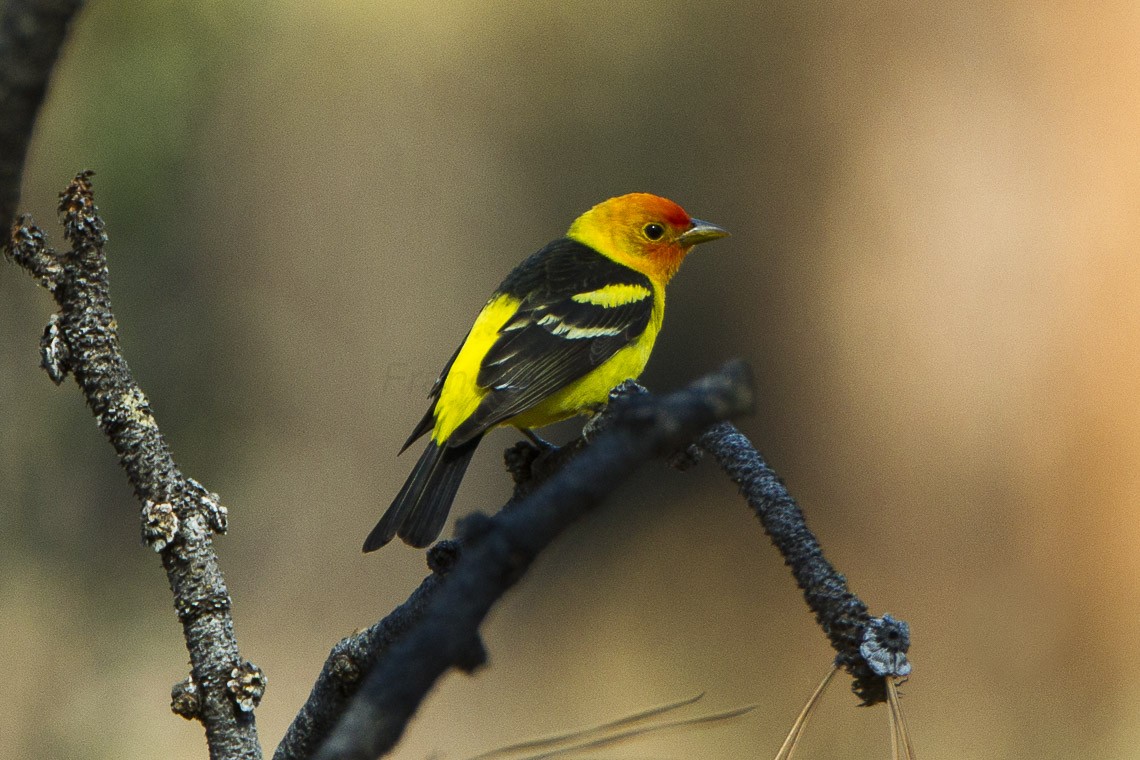Western Tanager
A species of Northern Tanagers, Also known as Western Piranga Scientific name : Piranga ludoviciana Genus : Northern Tanagers
Western Tanager, A species of Northern Tanagers
Also known as:
Western Piranga
Botanical name: Piranga ludoviciana
Genus: Northern Tanagers
Content
Description People often ask General Info
 Photo By Francesco Veronesi , used under CC-BY-SA-2.0 /Cropped and compressed from original
Photo By Francesco Veronesi , used under CC-BY-SA-2.0 /Cropped and compressed from original Description
The western Tanager is a colorful, medium-sized, stocky songbird that inhabits open woods. The red color of the male's plumage comes from the pigment called rhodoxanthin, and since birds can't produce this pigment, it's believed it must be obtained from the bird's diet. This skillful flyer forages tree canopies and is able to catch insects in flight. Its melodic call is often compared to that of a Robin.
Size
18 cm (7.25 in)
Life Expectancy
8-15 years
Nest Placement
Tree
Clutch Size
3 - 5 eggs
Nestling Period
11 - 15 days
Feeding Habits
Western Tanager predominantly consume insects like wasps, ants, and beetles, and fruits such as elderberries and blackberries. They display specific behaviors like wing-clipping dragonflies before consumption. Insect diet is common in breeding season, with fruit intake increasing during fall and winter. Occasionally, they eat plant buds and winter stragglers may visit feeders for seeds.
Habitat
Western Tanager's habitat spans open coniferous and mixed wooded areas in western North America, up to elevations of 10,000 feet. They flourish in regions abundant with Douglas-fir, ponderosa pine, and lodgepole pine. Their preferred settings include a mix of forest densities, notably riparian forests, aspen groves, and pinyon-juniper stands. Edge habitats, such as forest clearings and wetlands, along with suburban parks and gardens, are also integral. During migration, diverse habitats are utilized, and winter habits feature pine-oak woodlands in Middle America.
Nest Behavior
Western Tanager females solely construct the nest over 4-5 days. Males monitor as females weave a scaffold from twigs and roots, later lining it with softer fibers. Eggs are cared for by both parents post-laying.
Nest Characteristics
Western Tanager nests are loosely constructed, open, flat bowls with a small cup for eggs, made from twigs, stems, grasses, bark strips, and pine needles. They are lined with finer materials like rootlets and animal hair.
Dite type
Insectivorous
People often ask
General Info
Feeding Habits
Bird food type
Bird Feeder Type

Platform

Small Hopper

Small Tube Feeder
Sounds
Song
Recording location: United States
Behavior
Western Tanager typically engage in foraging activities high in the trees, meticulously searching for food amongst the branches and foliage. Their diet mainly consists of insects, which they capture by patiently observing before quickly darting out to snatch in flight, exhibiting their adept flycatcher-like skills. They are agile and robust fliers, capable of hovering momentarily as they pursue their prey. During breeding season, western Tanager's behavior becomes more prominent with persistent territorial singing by males and aggressive defense against potential threats by both sexes. Companionship is key, as mated pairs remain in close proximity during the critical stages of nest-building and egg-laying, with males sometimes nurturing their mates with food offerings.
Distribution Area
The breeding range of the western tanager includes forests along the western coast of North America from southeastern Alaska south to northern Baja California, Mexico. Western tanagers extend east to western Texas and north through central New Mexico, central Colorado, extreme northwest Nebraska, and areas of western South Dakota to southern Northwest Territories, Canada. The western tanager's wintering range stretches from central Costa Rica north through Nicaragua, Honduras, El Salvador, and Guatemala to southern Baja California Sur and extreme southeastern Sonora in western Mexico and to southern Tamaulipas in northeastern Mexico. Western tanagers do not typically occur in the Caribbean lowlands. They have been reported wintering further north and have been observed as far south as Panama. Vagrants are rare to casual in the eastern, United States. 
Species Status
Not globally threatened.
Scientific Classification
Phylum
Chordates Class
Birds Order
Perching birds Family
Cardinals Genus
Northern Tanagers Species
Western Tanager